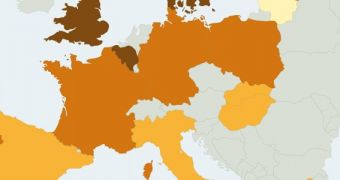A group of scientists with the European Union Reference Laboratory (EURL) for honeybee health in Sophia Antipolis, France, announced during a high-level conference held in Brussels on Monday, April 7, that some countries in the EU are losing up to a third of their bee colonies every year. The situation is especially dire for northern countries, though overall the results are better than scientists anticipated.
These conclusions belong to the first ever continent-wide survey conducted on European bees. The rate at which colonies are lost is not the same for every country in the Union. According to the presentation the EURL team held at the conference, southern countries exhibit bee mortality rates of less than 10 percent, while countries such as Germany and France lose 10 to 20 percent of their bees annually.
The highest levels were recorded for Sweden, Denmark, Estonia, and the United Kingdom, where bee colony loss rates exceed 20 percent consistently. Despite these very high values, analysts say that the overall results of the investigation are better than what scientists had feared. The world is currently faced with unprecedented levels of bee deaths, and experts cannot figure out what is killing the insects.
This is made abundantly clear by the fact that the thing that is killing off bees has been generically termed colony collapse disorder, since scientists do not really know what is causing it. Some studies have suggested that parasites, changing farming practices, and excessive use of insecticides may be to blame for CCD, but nothing has been settled for good, Nature News reports.
Bees are extremely important for the habitats they occupy, since they fertilize plants and help with pollination. Without these insects, vegetation would have a very hard time reproducing. The new study shows that Belgium is the most severely affected country in Europe, with bee decline rates reaching 33.6 percent.
At the opposite end of the spectrum is Lithuania, where loss rates are just 3.5 percent. Interestingly, only Latvia lies between Lithuania and Estonia, experiencing bee decline rates of more than 20 percent. Scientists are very interested in determining why two small countries located so close to each other exhibit such huge differences in terms of bee health.
Overall, the new study included data collected from 17 EU Member States. A total of 1,354 inspectors were involved in this research, which was carried out between autumn 2012 and summer 2013 and included a number of 8,500 visits to apiaries across the continent. EURL pathologist Marie-Pierre Chauzat says that the normal death rate of bees in apiaries should be somewhere around 10 percent.
“If that is the case, then the honeybee death rate is unacceptable in almost two-thirds of the member states. There are a lot of countries that are above this threshold. We’re not happy to see that,” Chauzat told attendants at the conference.

 14 DAY TRIAL //
14 DAY TRIAL //